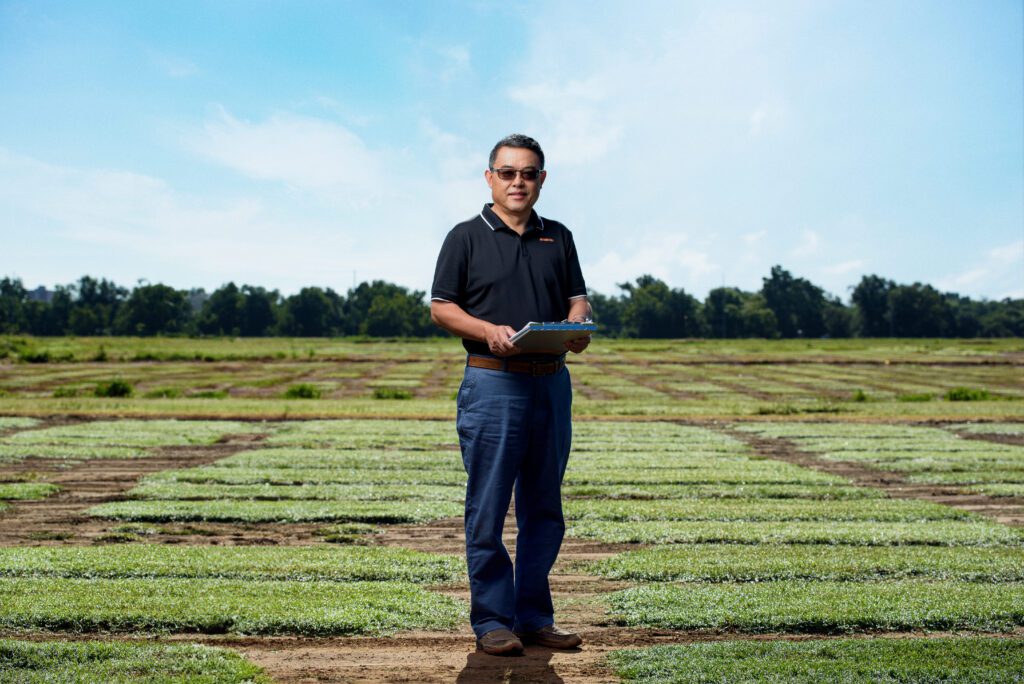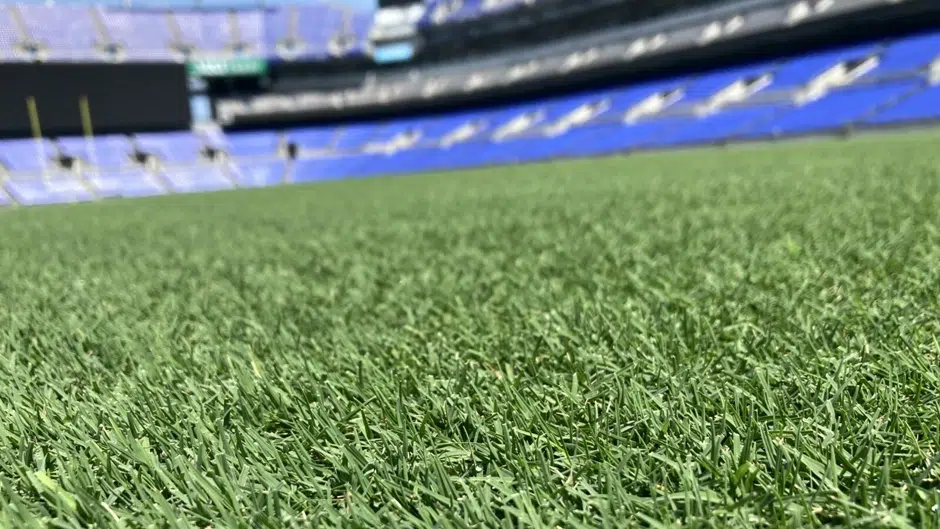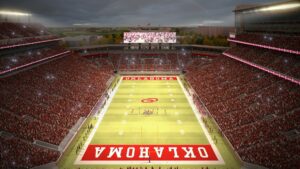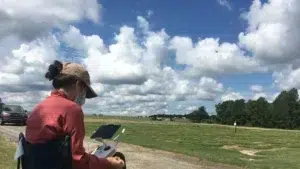Slippery Super Bowl just one of many challenges for Oklahoma State turfgrass breeders.
On Feb. 11, 2023, the Kansas City Chiefs met the Philadelphia Eagles for Super Bowl LVII. It was, according to nearly everyone, a slip-slidey mess. Some fans blamed players for not wearing the right cleats. The long-term groundskeeper blamed the field director. Many players and coaches looked to the grass: a warm season bermudagrass cultivar called Tahoma 31, bred by Dr. Yanqi Wu, a regents professor who leads Oklahoma State University (OSU)’s turf and forage breeding program.
It’s not easy breeding new turfgrass cultivars. It’s even more difficult breeding new turfgrass cultivars that will be tested to the limit in front of a live, national audience. Both of those challenges pale in comparison to the difficulty of breeding new turfgrass cultivars that will be successful despite the myriad complexities of a changing marketplace and changing climate.
The challenges of developing new turfgrass varieties
The turfgrass industry in the U.S. is large and growing. It is estimated the U.S. turfgrass acreage is about 45 to 50 million acres today – four times as many total acres as are planted to cotton in America, and about equal to the U.S. winter and spring wheat acreage combined.
Turfgrass is a perennial crop that, like any crop, must withstand multiple stress factors unique to the environment in which it is planted and cultivated. What’s unique about turf, however, is that a successful turfgrass variety must be suitable to a very wide geographic area.
“Unlike annual crops in which specific cultivars are grown in a small region or a single state or a few states, successful turfgrass cultivars should adapt to multiple states since the sod production area in each state is much smaller than that of field crops,” Wu says.
To determine performance in multiple regions, elite experimental lines must be tested in as many states as possible and over multiple years. That multi-location, multi-year testing is, not surprisingly, very expensive.
There are more challenges, too.
While there are many popular species of turfgrass, among the most desirable is bermudagrass, which happens to be Wu’s breeding specialty. A naturally warm season turfgrass, bermudagrass cultivars are grown extensively on home lawns, sports fields and golf courses in tropical, subtropical and transition climates. Bermudagrass is a cross-pollinated species. The genome of the grass carries many undesirable genes through a genetic mechanism called dominance. This makes weeding out less positive traits very difficult, as bermudagrass is highly self-infertile and must outcross to another genotype of its species to reproduce by seed.
“Due to its significant inbreeding depression in the species, it is extremely challenging to remove an undesirable or deleterious gene from the genome,” says Wu. “Therefore, the breeder has much less control over genetic improvement relative to major food crops, which have inbreeding systems established.”
Selecting for specific traits is equally challenging.
“From the genetic standpoint, each of the [desirable] traits is controlled by numerous genes. Hence, it is quite a challenge to pull these desirable traits together into one grass,” he explains.

Breeding for today’s new challenges
The OSU program generates a large volume of new plants — in the range of 10,000 to 60,000 genetically unique plants per year — through breeding efforts. These plants are screened, tested, and characterized by a team of interdisciplinary staff and students.
New cultivars need to combine high turf quality and other desirable traits (resistance/tolerance to abiotic and biotic stress) and as many positive production traits as possible. But there’s more: given significant water shortage pressures in many states today, the cultivars also have to offer improved drought resistance and water use efficiency.
Over the past 15 years, the OSU breeding program has been a participant in a collaboration between eight southern U.S. turfgrass breeding programs. The major goal of the collaboration is to improve drought resistance and water use efficiency in four important warm season turfgrasses, including bermudagrass.
“Drought resistance is a top priority trait we have focused on in turf bermudagrass cultivar development since 2010,” says Wu. “Our breeding and testing pipeline is full of experimental lines with improved drought resistance. A few best products will roll out to the market to save irrigation water substantially in the near future.”
The changing climate means OSU’s bermudagrass cultivars are being planted further and further north each year. That might work if climate change was a consistent warming trend. However, it’s not.
“A warming climate is favorable to expanding turf bermudagrass use to the north. However, the changing climate has a large variability between seasons and among years. Some winters in the transition zone or northern sites could be harsh to bermudagrass. To encounter the variability of winter weather, cold hardiness is still an important trait in new cultivars targeted to the regions,” Wu says.
Wu’s colleague, OSU professor and turfgrass research/extension specialist Dennis Martin says the unpredictability of today’s weather, including that caused by climate change, is the single biggest challenge to bermudagrass cultivation.
“The extremely rapid changes that we might see in weather are arguably the greatest threat [to bermudagrass]. Plants use a combination of both daylength and temperature to acclimate. When your day lengths are short, but your temperature suddenly goes into a fall or late summer condition when it should be cold, those plants can lose some of their cold hardiness, or deacclimate,” he says.
“This deacclimatization thing scares the heck out of me,” Martin adds. “Significant wild swinging weather events are an immense threat. What Dr. Wu and his team are asked to do is not only have great winter tolerance and great summer tolerance and excellent drought resistance and water use efficiency, but also people want late season color under chilly conditions and short-day lengths, and then there’s acclimation too, which is the next great challenge. It’s a lot of demands.”
Success despite challenges
Since the 1950s, scientists at OSU have collected a large number of bermudagrass plants and seed samples from around the world, including from across Africa, North America, South America, Asia, Europe, and Oceania. The globally distributed, natural bermudagrass germplasm collections provide enormous genetic variation for breeding work. From this germplasm, the OSU team has developed 10 commercially released cultivars: Midlawn and Midfield (joint releases with Kansas State University) in 1991, Yukon in 1996, Riviera in 2000, and Patriot in 2002. In 2010 the team released OKC1119 sold as Latitude 36® and OKC1134 sold as NorthBridge®. The most recently released (2017) and commercialized product from the OSU program is OKC1131, sold as Tahoma 31®.OKC3920 and OKC1876 were released 2022 but are not yet commercialized.
Martin says there have been major and continued advancements over the past 30 years in all individual performance traits, from attributes like fine texture, dark green color, high density and uniformity, to traits like freeze tolerance.
OSU’s releases have enjoyed commercial success and have been produced on more than 60 sod farms in the U.S., Australia, Brazil, Spain, Italy, Portugal, Turkey, Greece, Vietnam, Japan, and China. In the U.S. alone, they are produced in 18 states and used in 26 states.
Of OSU’s successes to date, Tahoma 31 is arguably its most important.
Tahoma 31 bermudagrass combines several desirable attributes including high turfgrass qualities (fine texture, high density, dark green color and uniformity), excellent freeze tolerance, top-tier traffic tolerance, exceptional divot recovery, outstanding spring green-up and improved water use efficiency, Wu lists with obvious pride. The grass also offers good shade tolerance relative to other bermudagrass cultivars, though bermudagrass in general has poorer shade tolerance than other turfgrass species.
Tahoma 31 also features very short internodes of its stolons and stems, which allows it to perform especially well under low mowing heights (5-15mm). This compatibility with low mowing makes it popular for fairways and tees of golf courses and – you guessed it – professional sports turfs including football fields.
“There are many good turfgrass cultivars available in the industry. A major step forward with Tahoma 31 is that it packages multiple desirable traits with several outstanding ones: cold hardiness, injury recovery, spring greenup, water use efficiency, and low mowing tolerance. This package of desirable traits probably has better capabilities to meet more consumer needs than some others,” says Wu.
Since its commercial rollout in 2018, Tahoma 31 has been embraced widely by the industry for use on golf courses, sports fields and, increasingly, on high-end home lawns too.
Super Bowl LVII was not Tahoma 31’s first brush with a professional sport. In fact, prior to the Super Bowl, Tahoma 31 had been successfully used on the gaming fields and/or training facilities of at least five NFL teams. It has even won awards: Tahoma 31 has been grown since 2019 on the Frank Broyles Field at the University of Arkansas, which was recognized as the 2022 and 2023 College Football Field of the Year by the Sports Field Management Association, says Wu.
What went wrong at the Super Bowl?
After having proved so successful at so many major events prior, what went wrong for Tahoma 31 at the Super Bowl?
Grass experts and laymen alike blamed overwatering, too little sun on the field, too little sanding and too much pre-game tarping in the days leading up to the game. They also blamed the turf variety itself.
“The slipperiness of the turf at the recent Super Bowl has received some criticism,” says Wu. “Some blamed Tahoma 31 for its newness and new use for football fields, which shocked us. Both the blames are not true. Tahoma 31 was created in 2007, has been tested in many environments and used on multiple football fields.”
Martin says the gaming surface of the Super Bowl was constructed by overseeding perennial ryegrass on the bermudagrass while still out in the sod production field.
“This is, in fact, old technology with respect to the techniques being used. The thick sod, like other bermudagrasses, is installed only weeks before game events,” says Martin. “Furthermore, fans saw Tahoma 31 overseeded with ryegrass and properly painted when they watched the NFC Championship game played just two weeks before at Lincoln Financial field in Philadelphia.”
Unfortunately, when the leaf surface of ryegrass is damp, it becomes slippery.
“This kind of phenomena is not new to turfgrass professionals as it has happened before,” says Wu. “How to remove moisture from leaf surfaces in the field or how to prepare the turfgrass should be addressed. It may need some focused research. Football fans expect high-quality turfgrass surfaces for football games, especially Super Bowl.”
Martin says there were issues beyond moisture — issues that no turfgrass cultivar could have withstood. He points to damning and furious comments made by George Toma, who has been head groundskeeper or served in a turf advisory management role for every Superbowl event since 1960.
“Mr. Toma in interviews widely reported on the internet indicated that he believed the field was in a state of decay as indicated by its smell prior to the game event. In review of these interviews, it appears that he indicated that he felt the field was watered heavily mid-week prior to the game event and was not allowed to dry out prior to the field being moved into the stadium. Furthermore, the field was tarped while in the stadium during the rehearsals for the half-time show,” he says.
Together, these factors contributed to a playing surface that was highly compromised before the Super Bowl began. Martin speculates that the bermudagrass actually in use for the Super Bowl was irrelevant since the event was a one-off.
“From my perspective as a co-inventor of Tahoma 31, I strongly feel that any high-quality ryegrass-overseeded bermudagrass properly marked and decorated with paint would have been suitable for the game and entertainment event, but the proper management of whatever surface is chosen largely determines the suitability of the surface for the game and half-time event,” he says.
Unfounded accusations about Tahoma 31’s role in a slippery Super Bowl are unlikely to impact its commercial success or its popularity on sports fields.
“Anyone who knows about turfgrass knows Tahoma 31 is preferred option,” say Wu. “I am confident it will stay a preferred option.”













